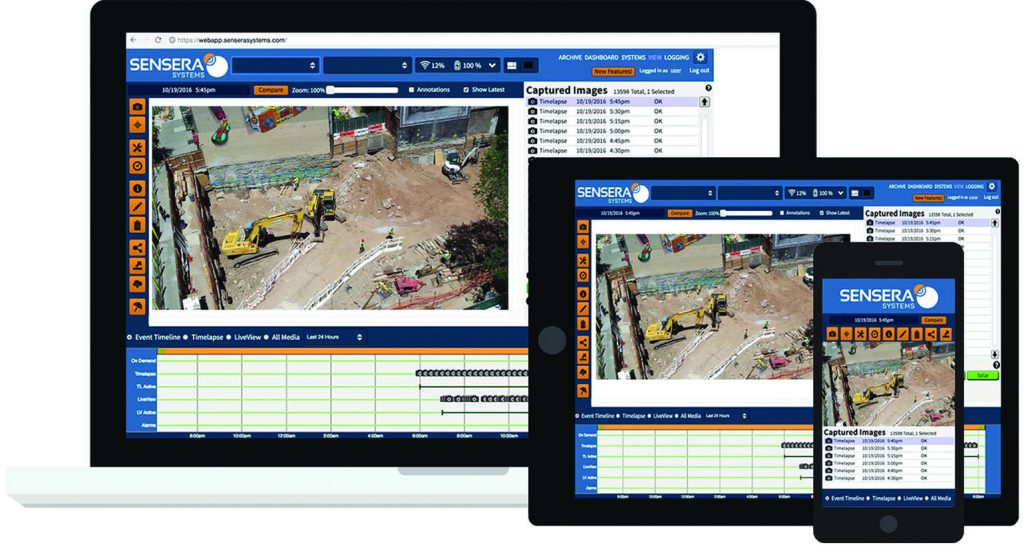The use of job site cameras is growing across the construction landscape. The contribution made by a network-connected series of cameras includes productivity, collaboration and safety. But can they backfire in terms of worker morale? The thought of being watched and possibly having one’s productivity measured risks reversing management’s best intentions.
Visual monitoring a work site remotely is not a new idea. A network of cameras recording images or video in real time is an idea that began a couple of decades ago in the form of basic webcams. As simple as they were — typically recording only still images in low resolution — they could be used to a create time-lapse series, useful for recording longer term progress.
What we are looking at today are jobsite camera systems that are far more advanced and offer many more benefits for project managers. The cameras themselves capture super-high resolution still and video images. What’s more, these cameras can be remotely controlled to tilt and zoom, in order to capture more viewing area as required.
Because the latest models are wireless and operate on a combination of battery and solar power, they can be quickly and easily installed in the most remote or hard-to-access locations as the project progresses. The imagery is transferred through a processor that, in the case of video, compresses the data for transport over a wireless network, or cellular data plan from a local provider. It is then sent to a cloud-based storage system such as SiteCloud.
Our cameras have weather and time stamps that can be used to develop history reports,
— Wendi Burke
Sensera Systems
From there, the imagery can be easily retrieved on desktops at head office or on hand-held devices on-site, allowing either real-time or programmed viewing later. The imagery can even be linked with alarms to security systems.
The potential benefits of this visual data can be assessed in terms of three fundamentals affecting project delivery: productivity; stakeholder collaboration; and safety management.
The productivity gains can be enormous, with the time savings alone recouping system costs through efficiency gains. Take rework, for example. Sensera Systems Inc., a U.S.-based provider of real-time jobsite monitoring solutions to several major Canadian clients, says that 52 per cent of rework is due to what it calls “poor project data”, often the result of several minor issues compounding over time. Another example of productivity and efficiency gains includes the reduction of on-site meetings. The ability to monitor progress in real time and have detailed imagery available for meetings at head office improves team communication and execution, since various delivery teams can better coordinate their efforts.
Real-time or date-stamped monitoring can also improve collaboration and transparency between the contractor and project stakeholders, explains Wendi Burke, director of marketing for Sensera Systems. “There can be discussions, perhaps leading to disputes, between owners and general contractors concerning whether work is being conducted on time. Our cameras have weather and time stamps that can be used to develop history reports. If the G.C. says a certain number of works days were lost because of snow, for example, that can be visually documented and referenced.”
And of course, risk management and accident prevention is preferable to a post-incident review. Burke explains how analytics can be used to control access to restricted areas. “Perhaps there is a crane on site, and people are taking unauthorised shortcuts underneath the crane or in the crane’s operating range. The cameras can send alerts as a notification.” The ability to recognise potential risks by monitoring a site remotely and continuously can also improve the security of equipment and materials.
With so many benefits, where do the problems arise?
First of all, there are legal issues to consider whenever an employer installs any workplace surveillance system. The courts do not always look favourably on employers who spy on their employees — it’s a matter of an employee’s right to privacy. However, in the case of workers working in plain view, such as on a construction site, the question of any expectation of privacy is largely mute. Also, while some union collective agreements may not permit workplace surveillance, the courts will likely consider whether the application of the monitoring system was reasonable under the circumstances.
This brings up the important issue of messaging. Failing to properly explain the purpose behind a network of job site cameras poses the risk that workers will feel personal output is being watched and somehow measured. This can reduce morale, causing them to feel de-humanized. If a project falls behind schedule for some reason, workers might view site monitoring as a management tool for unfairly attributing responsibility. This in turn can fester into distrust and resentment. Furthermore, the pressure of knowing the project is being visually monitored could add to worker stress or even increased risk-taking in order to be more productive.
Proper notice and communication, even on-site signage, can put many of these legal and morale uncertainties to rest. It’s critical that management takes the time to explain to their workers that the monitoring system is not an attempt to play Big Brother but to provide valuable data for the successful and safe completion of the project.
For all their ever- expanding benefits relating to project management during construction, however, it would be easy to overlook another key contribution of on-site cameras. The stunning videos produced after completion can be extremely valuable to a company’s marketing team as they pursue new business down the road.



Recent Comments
comments for this post are closed